(An anonymous patrix engraver at ATF; see About the Images.)
and also moldmakers (but not engineers of typecasting machines) and a few technically competent type designers.
(1) At present, I know of only one instance of matrix cutting by hand: the cutting of the "sanspareil" matrices by William Henry Garnet, first for Slater/Bower/Bacon and later for the firm which became Stephenson, Blake.
(2) Craftsmen cutting hand punches for making stencil plates (not uncommon in the 1870s) were engaged in an art scarcely distinguishable from type punchcutting, however different the intended use. I'll include them here, although I know of very few. (Note that in the contemporary literature the punches used in these sets were frequently termed "dies." It is often best to keep contemporary terminology, although this use would be incorrect in present industrial practice.)
Print culture, which to a very great extent created modern culture, was literally made not just by printers (who at least get their own chapter in the story) but by the artisans who made the matrices from which type was cast. To the best of my knowledge, as I start this Notebook in January 2009, there does not exist, anywhere, even a comprehensive list of these people (much less a study of the histories of their crafts). This present Notebook, then, is simply an attempt to identify and list all persons I can discover through research who contributed physically - via manual operations - to the making of punches, patrices, or matrices. It excludes, perhaps artificially, those who cast type. It also excludes, though less artificially (since my focus is on manual operations rather than design) drawing-office personnel who refined the designs of type designers. (The have been maligned greatly - indeed, often cast as the villains of the story - and certainly deserve their own Notebook.)
Note that because information on these people is generally so scarce, it is likely that I've made mistakes of categorization (and, of course, other mistakes as well) here. In particular, when my sources use the word "cut" too loosely to mean only "designed" rather than in fact "cut" (or "designed and cut"), some of these entries should probably be filed under Type Designers.
[TO DO: Review the early history of typefounding and punchcutting in Carter's edition of Mores' Dissertation.]

[FR] Constant Aubert
19th century. Imprimerie Nationale, France. Mentioned as having cut Syriac type in 1886 in Coakley, J. F. The Typography of Syriac: A Historical Catalogue of Printing Types (New Castle, DE: Oak Knoll and London: British Library, 2006. 1584561920.) A photograph of punches made and signed by various cutters, including "Aubert," is shown in the blog entry http://designtraveler.wordpress.com/2011/12/13/punch-cutter-nelly-gable-steel-magnolia-of-the-imprimerie-royale

[FR] Antoine Augereau
Reference in Nash, Paul W. "Journal of the Printing Historical Society INDEX [Nos. 1 to 28] to a citation of Antoine Augereau "punch-cutter / printer at Paris" in the Journal of the Printing Historical Society, No. 28, note 46.

[UK] Richard Austin
Richard Austin (d. 1824) Punchcutter for Simeon & Charles Stephenson (British Letter Foundry); freelance punchcutter with work for William Miller (Edinburgh) and Alexander Wilson (Glasgow). Typefounder from 1815 (as Richard Austin, or Imperial Letter Foundry, or Richard Austin & Son.)

[US] Charles Henry Beeler
Engraver. d. 1934-01-19. First at MacKellar, Smiths & Jordan. Then American Type Founders. Then Lanston Monotype Machine Company, where he became head of the "Special Matrix Department."
Obituary in The Inland Printer. Vol. 92, No. 5 [TO DO: get and reprint] (February 1934): 72.
See Hopkins, Richard L. Tolbert Lanston and the Monotype (Tampa, FL: University of Tampa Press, 2012): 193.
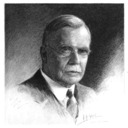
[US] Linn Boyd Benton
For Northwestern Type Foundry (Benton, Waldo) and then American Type Founders.

[UK?] Emile Bertaut
An independent punchcutter associated at times with Stephenson, Blake and with the introduction of the Benton punch engraving machine to that firm.

[UK] Anthony Bessemer
1813-1832. Father of the Bessemer of steelmaking fame. In 1822 took in partnership John J. Catherwood, late of the [Henry] Caslon [II] firm. { Reed 358}, { Moseley, James, Justin Howes, and Nigel Roche. Founder's London A-Z. (London: The [European] Friends of the St. Bride's Printing Library, 1998.) , p. 14} note that Bessemer was a "prolific punchcutter" who cut 44 types for the Caslon firm.

[UK] "The Black Man"
Mysterious (and nameless) punchcutter who worked for Joseph Jackson and later Vincent Figgins. { Reed, p. 338}
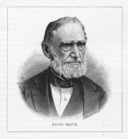
David Bruce, Jr.
Son of David Bruce Sr. (who had co-founded what became Bruce's New York Type Foundry, but who had retired circa 1822 and left the operation of that foundry to his brother George Bruce).
Inventor of the pivotal type casting machine.
Also early work with Darius Wells on wood type routing machinery. May have assisted in the transfer Leavenworth's pantograph engraving machine for wood type to Wells & Webb.
The Bruce family, in two branches over two generations, was one of the most important in the history of American typefounding. But identifying the individual members can be confusing - and to add to the confusion I've placed the information on the various Bruces under different categories in these Notebooks. Most of the information here is from { Annenberg 1994}.
David Bruce (Sr.) and his younger brother George Bruce (Sr.) were the initial pair of brothers who began what became Bruce's New York Type Foundry. (They had another brother, John, who appears not to have participated in the foundry business.) Even though they were both practical printers and probably practical typefounders (and though David Bruce (Sr.) learned plaster stereotyping), I've filed them under ../ Engineers, Works Managers, and Owners because that is how they are primarily remembered. The Bruces were themselves financially successful, and George Bruce, further, married an heiress: Catherine Wolfe (1785-06-21 to 1861-03-18 { Geni CWB}), the daughter of "the great hardware merchant and real estate investor" John David Wolfe ({ Millionaires 1892}: 59).
David Bruce Jr. was of course the son of David Bruce Sr. and therefore the nephew of his uncle George Bruce and cousin to George Bruce's sons David Wolfe Bruce and George Wolfe Bruce. I've filed him here under Punch, Patrix and Matrix makers because he was a practical punchcutter rather than a capitalist (he abandoned his interest in the family typefoundry to pursue his inventions). He might also be categorized as an engineer because he invented the pivotal type caster, but it's best to put all of his information in one place, so he's here.
David Wolfe Bruce was the son of George Bruce and co-inheritor, with his brother George Wolfe Bruce of Bruce's New York Type Foundry. I've filed him under ../ Engineers, Works Managers, and Owners because he was primarily an owner rather than a practical typefounder.
George Wolfe Bruce was the son of George Bruce and co-inheritor, with his brother David Wolfe Bruce of Bruce's New York Type Foundry. I've filed him under ../ Engineers, Works Managers, and Owners because he was primarily an owner rather than a practical typefounder.
I am unaware of any continuation of type founding in this family beyond this generation. David Wolfe Bruce disposed of his stock in the Bruce foundry to four employees upon his retirement in 1890 { Annenberg 1994}: 82.

[US] William F. Capitain
Cut Ebony, which was used by the Oliver Typewriter Company as its offical typeface.

[US] John S. Carroll
In 1960s recut several antique faces. Had own typefoundry, Replica Type Foundry. Materials possiby to Typefounders, Inc. [of Phoenix].

[US] John Cumming
Worcester, MA. ATF. Cut punches for Rogers' Montaigne

[US] Micah Currier
Proprietor of The Dale Guild. Actively engaged in cutting matrices for new metal types, using Benton-designed equipment recovered from the former American Type Founders Company.

[?] Pedro Disses
Cruickshank, Don W. "The Types of Pedro Disses, Punchcutter." Journal of the Printing Historical Society. No. 17. (ca. 1982/1983)

[US] Paul Hayden Duensing
Kalamzoo and Vicksburg, MI. One of the most important, and without question the most scholarly, of the core group of people associated with the American Typecasting Fellowship who preserved the methods of metal type making through their demise as a commercial proposition into their present survival on a smaller scale.
For a more comprehensive bibliography of works written and/or printed by Paul Hayden Duensing, see ../../../ Noncomposing Typecasters -> Fine Press and Amateur Typecasting --> The Private Press and Typefoundry of Paul Hayden Duensing. Here is a short and insufficient list of some of his work as a maker of new types:
(See the chapter "Contemporary Private Types" by Duensing in David Pankow, ed. American Proprietary Typefaces ([no location]: American Printing History Assn., 1998), pp. 166-176 (esp. p. 175) for more.)

[Netherlands, UK] Dummers
fl. 1734. Dutch, resident in England. Apparently a punchcutter who cut a pica fount of matrices for the Samaritan alphabet for Caslon. { Reed 345}

[US] Andrew Dunker
An important figure in the 20th century revival of "antique" (19th century ornamental) types. A maker of astonishingly good matrices. he electroformed them into a single solid mass (not an inset in a brass planchet) and then machined that mass down using a metalworking shaper (not a milling machine; the patterns of straight lines on a Dunker matrix are distinctive). See the entry on him in the typefoundry page under Andrew Dunker.

[UK] Edmiston
Edmiston, or Edmonston. fl. 1815. Cut punches for the Figgins and Caslon foundries. { Moseley et al., Founder's London A-Z }

Fraser Engineering (New Zealand)
A general engineering firm, located in Lower Hutt, New Zealand. Their emphasis is fire engines; they are "the leading manufacturer and supplier of Fire and Rescue Products in New Zealand" [from their website, 2016-07-02] http://www.fraser.org.nz
In 2016, they cut (by CNC milling the matrices) David Kindersley's 1952 lettering design, MoT Serif for the The Printing Museum / Whare Taonga Perehitanga, Upper Hutt, New Zealand.

[CH] Hans-Ulrich Frey
Offizin Parnassia Vättis. Uses a Michael Kampf commercial horizontal-format pantograph engraving machine. Has re-cut Morris' Troy Type.

[UK] William Henry Garnet
Cut "sanspareil" matrices, first for Slater/Bower/Bacon and later for the firm which became Stephenson, Blake. See { Millington}

[FR] Louis Gauthier
France. 1916-1993. With Deberny & Peignot. Cut Luce ( Imprimerie Nationale, 1963). Cut Gauthier ( Imprimerie Nationale, 1969). {Information from Luc Devroye's page on Louis Gauthier, http://luc.devroye.org/fonts-33812.html} A photograph of punches made and signed by various cutters, including "Gauthier," is shown in the blog entry http://designtraveler.wordpress.com/2011/12/13/punch-cutter-nelly-gable-steel-magnolia-of-the-imprimerie-royale

[German Empire, UK] Karl Görner
Apprenticed under William Kirkwood in Frankfurt. Worked for Stephenson, Blake 1907-1959. Millington calls him "the last of the line of traditionally trained punchcutters" at Stephenson, Blake. See { Millington, pp. 127-128}

[UK] William Grandison
Died 1884. At Miller & Richards. Moved to Stephenson, Blake in 1877. Moved to the Isle of Wight in 1883 due to tuberculosis, continuing to cut punches for Stephenson, Blake until his death. See { Millington, p. 125}

[US] William C. Gregan
ATF. Cut the 1994 American Typecasting Fellowship commemorative casting matrix on an ATF Ad-Cut pantograph engraver for The Dale Guild. { Hopkins, Richard L. American Typecasting Fellowship Commemorative Casting / Story Behind the Engraved Matrix . (Terra Alta, WV: Hill & Dale Private Press and Typefoundry, 1994.) }

[Germany, US] Victor Hammer
Learned to cut punches for his later types. Covered here in the Type Designer set of Notebooks (the blank image at left links "up and over" to those Notebooks).

[US] John E. Hanrahan
[See Annenberg, Type Foundries of America and their Catalogs , p. 222.]
Note also that Hanrahan was one of the founders of Compositype, and that while the Compositype machine was not a great commercial success the Compositype matrix library was important for both the Nuernberger-Rettig and the Thompson type casters. Hanrahan's influence on early 20th century type is probably larger than is generally recognized.

[UK] John Hemingway
Worked apprenticed at Stephenson, Blake, and joined that firm in 1842. See { Millington, p. 123}

[FR] Jules Hénaffe
19th & early 20th century. Imprimerie Nationale, France.

[US] Charles L. Hochstadt
St. Louis. Maker of electrolytic matrices in nickel.

[Germany] Louis Hoell
[See letter by Joseph Blumenthal in Fine Print Vol. 12, No. 4 (October, 1986): 235-236) for discussion of Hoell and his association as a punchcutter with the type designer Willy Wiegand (Bremer Presse, Munich).

[UK] William Howard
by 1827 - 1864. Punchcutter and typefounder. Cut and cast the Caxton and Basle types circa 1850 for The Chiswick Press (punches and matrices now at St. Bride's Library, via the Chiswick Press). See "Typefoundry" [the blog of James Mosley] , especially "Recasting Caslon Old Face" (2009-01) and "The Materials of Typefounding" (2006-01) { Moseley et al., Founder's London A-Z , p. 23}
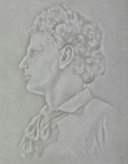
Dard Hunter, Sr.
William Joseph ("Dard") Hunter (1883 - 1966). Primarily a papermaker, he cut by hand (punchcutting in steel) a face of his own design between 1912 and 1915.

Dard Hunter, Jr.
Dard Hunter, Jr. [aka Dard Hunter II] Cut by hand (punchcutting in steel) a face of his own design between 1936 and 1939.

[US] Herman Ihlenburg
N.B. The Melbert B. Cary Graphic Arts Collection at the Rochester Institute of Technology has 6 boxes of Ihlenberg's papers: Collection page at: http://library.rit.edu/cary/collections/hermann-ihlenburg-papers RIT Library record at: http://albert.rit.edu/record=b2723625~S3

[Germany] Heinrich Jost
"Cut" Beton for Bauer [TO DO: Verify as punchcutter, not simply type designer.]

[UK, German Empire] Kirkwood [father to William Kirkwood]
Scottish, trained at Miller & Richard. "subsequently found employment at a German typefoundry and having married a German, had a son, William Kirkwood. See { Millington, p. 127}

[German Empire, UK] William Kirkwood
Son of Kirkwood; trained under his father. Joined Stephenson, Blake (it must have been circa 1892, as he was there "ten years"). Returned to German in 1902. Continued freelance work for Stephenson, Blake, though less after death of Henry Stephenson in 1904. See { Millington, pp. 127-128}

[Germany] Paul Koch
Cut punches for Victor Hammer's " Samson" (1926)
N.B., for his father, Rudolf Koch, see the Type Designers Notebooks.

[US] Ernst Lauschke
(Luc Devroye cites him as "Ernst Johnston (Edward) Lauschke ... b. Germany 1872, d. 1944", but he does not cite his sources.)

[US] Harrison T. Lounsbury
[TO DO: add the faces he did for Bruce which were revived in the 20th c. as "Tuscans"]

[FR] Charles Malin
Cut Dante for Giovanni Mardersteig and Perpetua (Dumas, Monotype)
Sources: No doubt many, but I first encountered reference to his cutting of Dante and Perpetua in C. Volmer Nordlunde's Letters from a Danish Typographer [Typophiles Chap Books, No. 46] (NY: The Typophiles, 1967), p. 63.

[US] Walker [Walter?] Malowski
Cut Torvald Faegre's typeface for a Cherokee syllabary for Triangle Type Foundry.
Name cited as "Walker" in White, John K. "On the Revival of Printing in the Cherokee Language." Current Anthropology: A World Journal of the Science of Man. Vol. 3, No. 5 (December, 1962): 511-514 . Name cited as "Walter" in catalog card for Smithsonian item USNM No. 400096 (accession number 242882) .

[UK] William Martin
[TO DO: sort through the details of Martin's types; clarify which one served as the model for the modern "Bulmer"] 1786-1790; 1790-1817. Reed (330) says that William Martin, as the brother of Baskerville's apprentice Robert Martin, "acquired his first knowledge of the art at the Birmingham foundry" [that is, at Baskerville's]. In 1786 he "entered into the service of" the King's bookseller, George Nicol (1740? - 1828) as a punchcutter and typefounder. Nichol started The Shakespeare Press in 1790 and Martin continued as private typefounder to the Press. He created (designed, cut, and cast) a typeface for the Press which has since been revived as "Bulmer" (after the printer to the press, William Bulmer, who, with Nicol, provided advice). Materials to Caslon by purchase in 1817. { Reed 330}

[UK] Fred McKrell
An "expert matrix-maker" for The Monotype Corp. Ltd. (UK) sent by them to Hartzell Machine Works to assist in matrix manufacture there during the period in which Hartzell owned the ex-Lanston matrix department. Hartzell owned the Lanston matrix equipment from 1975 to 1983. See Hopkins, Richard L. Tolbert Lanston and the Monotype (Tampa, FL: University of Tampa Press, 2012): 154.

[UK] James McLaren
Trained as a mold maker at Miller & Richards. Moved to Stephenson, Blake as a mold maker and then learned punch cutting from William Oliver. See { Millington, p. 124}

[UK] William Meggitt
Apprenticed at Stephenson, Blake first to William Grandison until Grandison's death in 1883 and then to Frederick Tarrant. See { Millington, pp. 125, 127}

[UK] Isaac Moore
1776 - at least 1787. Isaac Moore was a punchcutter and the foundry manager for Fry. Left 1776 to set up as "letter founder and printer". Succeeded by Joseph Moore, his son, 1781. { Reed} { Moseley et al., Founder's London A-Z , p. 18}
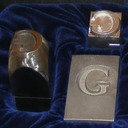
Raymond Stanley Nelson, Jr.
Hand punchcutter and type caster; authority on the type founder's hand mold. Maker of new 18th century hand molds.

[UK] William Oliver
At Figgins and then Stephenson, Blake from 1857 through 1878. See { Millington, p. 123-124}

Phil. T. Nuernberger
Also a designer and manufacturer of typecasting machinery. See the Nuernberger-Rettig Typecasting Machine.

[US] Sarah Osborne
St. Louis. "The Inland Type Foundry had the services of Miss Sarah Osborne as an operator of a [pantograph matrix engraving] machine, under my tuition, and she did most creitable work."

[UK] Edward Philip Prince
English. Probably as famous as punchutters get. Cut punches for Morris' types ( Golden (1890-1891), Chaucer (1891)/ Troy (1892)) and Cobden-Sanderson's Doves Type.

[FR] Georges Plumet
France. G. H. Plumet. Punchcutter. Cut punches for Warde's Arrighi. See Johnson, Herbert H. "Notes on Frederic Warde and the True Story of His Arrighi Type." Fine Print. Vol. ?, Nos. ? (July, 1986). San Francisco, CA: Fine Print, 1978 . [Reprinted in Fine Print on Type (1989): 106-113.] Johnson's article contains photographs of these punches.

Ribadeau Dumas
Typefounder (foundry: Ribadeau Dumas (?). "Ribadeau Dumas" is the surname. Struck the matrices for Perpetua (Dumas, Monotype) which had been cut by Charles Malin; cast from these in 1926. Punches later to The Monotype Corp. Ltd. (UK). C. Volmer Nordlunde's Letters from a Danish Typographer [Typophiles Chap Books, No. 46] (NY: The Typophiles, 1967), p. 75.

[US] Rice
US. Electroformed matrices. Rice, Roy. Matrix Making at the Oxford University Press: With notes on the same process as used at The Recalcitrant Press. Atlanta, GA: The Recalcitrant Press, 1982.

[Canada] Jim Rimmer
[MUCH TO DO here; the late Jim Rimmer has been an inspiration to me. Patrix cutter, patrix engraver, matrix engraver, casterman, type designer, printer, artist.]

[UK] James McLaren
Originally in Paris. Employed fora time by Stephenson, Blake. Then worked in London for H. W. Caslon. Then freelance in London. See { Millington, pp. 124-125}

[Germany] August Rosenberger
1893-1980. Worked for Stempel. See Duensing. "A New Civilité" in Fine Print. Vol. 11, NO. 1 (January, 1985): 35-41 . If I understand Duensing correctly, Zapf designed two pages based on Civilité for Pen and Graver (NY: Museum Books, Inc., 1952) which were engraved by hand directly on lead plates by Rosenberger.

[UK] James Ross
Worked with the firm which became Stephenson, Blake in the 1831-1835 timeframe. See { Millington, p. 122}
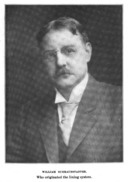
[US] William A. Schraubstadter
One of three sons of Carl Schraubstadter. At Central Type Foundry, when it was owned by his father, he was the operator at the cutting of the first matrices by machine in America.

[US] Gustave F. Schroeder
First for Central Type Foundry, then in partnership with Nicholas J. Werner as Schroeder & Werner, commercial matrix engravers. In 1891 this partnership was dissolved and Shroeder moved to California. [4] Purchased the Central Type Foundry Pantograph and designed the Schroeder-Boyer Pantograph Designed and cut DeVinne while in partnership with Werner, under contract to Central. Schroeder estimates that he designed and cut "about thirty" faces. He isn't included in McGrew's list of "The Most Prolific Type Designers" ( American Metal Typefaces..., p. 154), but this would put him in ninth place). I count something more like fifty faces, though.

[Austria] A. Schuricht
Vienna. Cut punches for Victor Hammer's " Hammer Unziale" ( Klingspor, 1923). May have taught Hammer punchcutting, or at least was observed by Hammer while punchcutting.

[US] A. R. Soulé
US. Electroformed matrices. { Soulé, A. R. Electro-Formed Matrices / Electro-Forming. Paper presented at the second annual Conference of the American Typecasting Fellowship, held in NY in 1980 under the name "Second National Conference on Typecasting and Design." }

[US] Edwin Starr
By 1814 to 1853. Very complex life. First person in America to "regularly engage" in punchcutting as an occupation. { Annenberg, Type Foundries of America and their Catalogs , 113}

[UK] Frederick Tarrant
fl. 1862-1883. Trained Edward Philip Prince. See Avis, F. C. Edward Philip Prince: Type Punchcutter. London: For the Author, 1967.
Worked with Fann Street Foundry (Fox Reed). Then Stephenson, Blake from 1883. See { Millington, pp. 125-126}

[UK] Tarrant [son of Frederick Tarrant]
Apprenticed under his father, Frederick Tarrant at Stephenson, Blake (not entirely clear if he completed this apprenticeship). See { Millington, pp. 125, 127}

[UK] John E. Uttley
With Stephenson, Blake. Was trained on the Schokmiller pantograph by Nicholas J. Werner.

[UK] Francis Hayes Tice
Originally a non-type engraver at Thomas De La Rue and Company. Apprenticed under Frederick Tarrant at Stephenson, Blake. (But Millington's account of him isn't entirely clear.) Left Stephenson, Blake after five years. See { Millington, p. 127}

[US] Wehrle, John M.
Cut "many [sizes of] the Penman Scripts" (see James Madison Conner 1887 article on "Electrotype Matrices" in The Typographic Messenger .) in steel. Claimed by James M. Conner as "having first cut type in metal [meaning typemetal] in this country."

[US] Harry Weidemann
An important figure in the mid-20th century American revival of "antique" typefaces. See the entry on him in the typefoundry page under Weidemann.

[US] Nicholas J. Werner
Not to be confused with August E. Woerner.
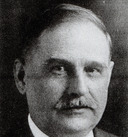
[US] Robert Wiebking
The forgotten critical figure in American typemaking.
{Geni CWB} Entry for Catherine Bruce (Wolfe) at Geni.com website: https://www.geni.com/people/Catherine-Bruce/6000000011334973727
{Annenberg 1994} Stephen O. Saxe [additions, intro], Elizabeth K. Lieberman [index]. Type Foundries of America and their Catalogs New Castle, DE: Oak Knoll Press, 1994.
{Millionaires 1892} The Tribune Monthly. Vol. 4, No. 6 (June 1892). Issue subject: "American Millionaires: The Tribune's List of all Persons in the United States Reputed to be Worth a Million or More."
Digitized by Google from an unknown library's copy, Google Books ID: wJFOAQAAMAAJ.
All portions of this document not noted otherwise are Copyright © 2008, 2011, 2022 by David M. MacMillan.
Circuitous Root is a Registered Trademark of David M. MacMillan.
This work is licensed under the Creative Commons "Attribution - ShareAlike" license, version 4.0 International. See http://creativecommons.org/licenses/by-sa/4.0/ for its terms.
Presented originally by Circuitous Root®